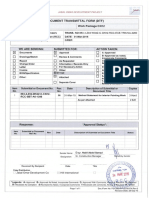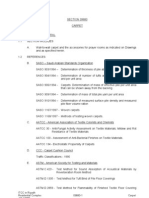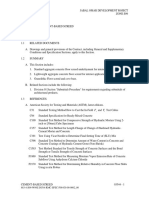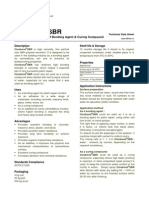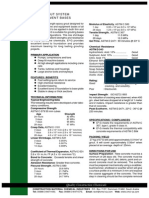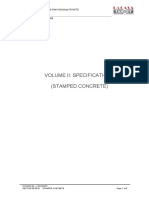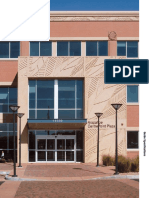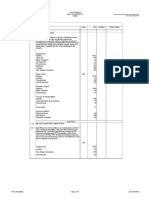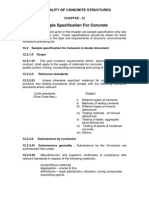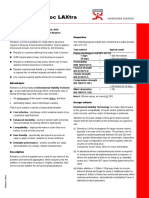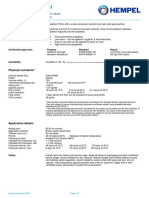04200
04200
Uploaded by
uddinnadeemCopyright:
Available Formats
04200
04200
Uploaded by
uddinnadeemCopyright
Available Formats
Share this document
Did you find this document useful?
Is this content inappropriate?
Copyright:
Available Formats
04200
04200
Uploaded by
uddinnadeemCopyright:
Available Formats
SECTION 04200 UNIT MASONRY 00000000PART 1 - GENERAL 1.1 SECTION INCLUDES A. 1.
2 Concrete unit masonry and related accessories for walls and partitions as indicated on Drawings.
REFERENCES A. SASO - Saudi Arabian Standards Organization: SASO 87 and Blocks SASO 145 SASO 144/1979 SASO 186 Methods of Test for Concrete Building Bricks Concrete Hollow Blocks for Building
Solid concrete (Cement) building bricks.
Hollow Blocks Made From Burnt Clay
SASO 184/1980 - Methods of test for bricks & blocks made from burnt clay. SASO 185/1980 - Bricks made from burnt clay SASO 227/1981 - Methods of testing test sieves. SASO 1580/1999 - Lightweight Aggregates for concrete. B. ASTM - American Society for Testing and Materials: ASTM A 82 Specification for Cold-Drawn Steel Wire for Concrete Reinforcement
ASTM A 153 Specification for Zinc Coating (Hot-Dip) on Iron and Steel Hardware ASTM C 33 ASTM C 90 Specification for Concrete Aggregates Specification for Hollow Load-Bearing Concrete Masonry Units
ASTM C 144 Specifications for Aggregate for Masonry Mortar ASTM C 150 Specification for Portland Cement ASTM C 207 Specification for Hydrated Lime for Masonry Purposes ASTM C 270 Specification for Mortar for Unit Masonry ASTM C 426 Drying Shrinkage of Concrete Block ASTM E 149 Bond Strength of Mortar to Masonry Units
ITCC in Riyadh Residential Complex J10-13300
04200-1
Unit Masonry
1.3
ICBO - International Conference of Building Officials: UBC Uniform Building Code
1.4
SUBMITTALS A. Product Data: Submit manufacturer's product data, including laboratory test reports for each type of concrete masonry unit, accessories and other manufactured products, as well as certifications of compliance with the specified requirements for each type. Shop Drawings: Submit cutting and setting drawings for trim units showing sizes, profiles and locations of each unit required. Samples: Submit concrete unit masonry samples showing color and texture as well as ties and anchors for the Engineer selection and approval.
B. C. 1.5
TRANSPORTATION, HANDLING AND STORAGE A. Deliver masonry materials to site in an undamaged condition marked with name of manufacturer and identification of contents. Store masonry materials under waterproof covers on planking clear of ground and protected from damage, dirt, stain, water and wind.
1.6
QUALITY ASSURANCE A. Engage a commercial testing laboratory approved by the Engineer to perform tests as specified below at no extra cost to Owner. Submit information regarding testing laboratory and qualifications of technical personnel to the Engineer for approval. Tests: Testing laboratory shall test mortar materials, mortar and masonry panels as specified. Certified test reports shall identify materials by type, brand name and manufacturer and/or by origin. Use no mortar materials until laboratory test reports are approved by the Engineer. After tests have been made and materials approved, no changes shall be made without additional test and approval of the Engineer. Testing: Materials proposed for use shall be tested for compliance with specifications in accordance with test methods contained in the referenced specifications and as follows: 1. Mortar Type N: Test for compressive strength and water retention. Mortar Type N shall have a compressive strengths at 7 days and 28 days as follows: 2. D. 3.10 MPa at 7 days 5.17 MPa at 28 days
B.
C.
Concrete Unit Masonry: Test for compressive strength, weight and water absorption.
1.7
Mock-Up: Before starting masonry work, construct sample panel 3 m long by 2 m high for the Engineer's approval. JOB CONDITIONS
ITCC in Riyadh Residential Complex J10-13300
04200-2
Unit Masonry
A.
Protect partially completed masonry against weather, when work is not in progress, by covering top of walls with strong, waterproof, non-staining membrane. Extend membrane at least 600 mm down both sides of walls and anchor securely in place.
PART 2 - PRODUCTS 2.1. MATERIALS A. Concrete Unit Masonry: 1. Manufacturer: Obtain concrete masonry units from one manufacturer, of uniform texture and color for each kind required for each continuous area and visually related areas. Hollow Concrete Unit Masonry: Conform to SASO 87, SASO 145 or ASTM C 129, Type 1, normal weight and shall be of regular standard nominal sizes not less than 400 x 200 mm with standard widths as shown on the Drawings and permissible variations in dimensions of individual units not more than plus or minus 4 mm. Minimum thickness of face shell (FST)/web (WT) shall be 35 and 29 mm, respectively. Provide units with a compressive strength of not less than 4.14 MPa, oven-dried weight (concrete) over 2000 kg/m and water absorption of maximum 25 percent by weight for individual block. Provide half units for ends. Special Shapes: Provide where shown and where required for lintels, corners, jambs, sash, control joints, headers, bonding and other special conditions. Exposed Face: Provide manufacturer's standard color and texture unless otherwise indicated. Field Testing: Tests of concrete masonry units shall be completed in accordance with ASTM C 140 prior to installation of masonry.
2.
3.
4. 5. B.
Pre-Insulated CMU Blocks: 1 Pre-insulated blocks shall comply with requirements applicable to normal masonry units with 45 mm thick polystyrene sandwiched in the core of the block thereby insulating 85% of face area of the blocks and reducing thermal energy flow through the face of the block by 75%. Thermal conductivity of pre-insulated blocks shall be 0.14 Watts/Meter/Kelvin and U value of 0.514 W/ (SQ.M.K.). Sizes: Manufacturers standard sizes with thickness as indicated on drawings.
2. C.
Mortar and Grout Materials: 1. Portland Cement: ASTM C 150, Type I. Provide natural color cement as required to produce the required mortar color. Hydrated Lime: ASTM C 207, Type S.
2.
ITCC in Riyadh Residential Complex J10-13300
04200-3
Unit Masonry
3. 4. 5. 6. D.
Sand (for Mortar): ASTM C 144, except for joints less than 6 mm use aggregate graded with 100 percent passing the No. 16 sieve. Fine Grout: Consist of fine aggregate conforming to ASTM C 404, size No. 1. Use fine grout in cells containing pipes and conduits. Coarse Grout: Consist of fine and coarse aggregates conforming to ASTM C 404, size No. 89. Water: Clean, potable and free of deleterious materials.
Mortar and Grout Mixes: 1. Measurement: Use methods which will ensure that required proportions are controlled and accurately maintained. Measure aggregate materials in a damp, loose condition. Mortar: Comply with ASTM C 270, Type N for interior and Type S for exterior. Grout: Comply with ASTM C 476; grout to be used in cores where reinforcements are placed. Mixing: Combine and mix cement, lime, water, and aggregates for a minimum of 5 minutes in a mechanical batch mixer. Do not add air-entraining agents or other admixtures to mortar or grout materials unless otherwise indicated on Drawings or instructed by the Engineer. Do not use calcium chloride in mortar or grout.
2. 3. 4. 5.
6. D.
Reinforcing Bars: 1. Reinforcing bars shall conform to ASTM A 615, Grade 60, deformed; sizes as indicated on Drawings.
E.
Masonry Accessories: 1. Joint Reinforcement and Ties for Masonry: a Provide welded wire units from cold-drawn steel wire complying with ASTM A 82, with deformed continuous side rods and plain cross-rods, and a unit width of 38 mm to 50 mm less than thickness of wall or portion. Reinforcement shall be hot-dip galvanized after fabrication with 22 grams zinc-coating conforming to ASTM A 116, Class 3. Provide type of reinforcement as follows with 3.76 mm single pair of side rods:
1) 2)
ITCC in Riyadh Residential Complex J10-13300
Ladder design with perpendicular 3.76 mm cross rods spaced not more than 400 mm on center. Truss design with 3.76 mm continuous diagonal cross rods
04200-4 Unit Masonry
spaced not more than 400 mm on center. 2. Anchoring Devices for Masonry: Provide straps, bars, bolts and rods fabricated from not less than 3.76 mm sheet metal or 10 mm diameter rod stock, unless otherwise indicated. Concrete Inserts for Masonry: a Unit Type: Furnish cast iron or malleable iron inserts of the type and size shown, hot-dip galvanized after fabrication with 44 grams zinc coating, ASTM A 153, Class B 2. Dovetail Slots: Where shown, furnish dovetail slots with filler strips, hot-dip galvanized as above. For installation of concrete inserts refer to the concrete Sections of these Specifications as well as the specific requirements of the concrete installer regarding placement of inserts which are to be used by the masonry installer for anchoring of masonry work.
3.
b c
4.
Pre-molded Control Joint Strips: Solid rubber strips with a durometer hardness of 60 to 80 as determined by ASTM D 2240, designed to fit standard sash block and maintain lateral stability in masonry wall, size and configuration as indicated.
PART 3 - EXECUTION 3.1 INSTALLATION A. B. Installation: Conform to the requirements of latest edition of UBC. Thickness: Build masonry construction to full thickness shown on Drawings. Build single-width walls to the actual thickness of the masonry units, using units of nominal thickness indicated. Build chases and recesses as shown or required to accommodate items specified in this and other Sections of the Specifications. Provide not less than 200 mm of masonry between chase or recess and jamb of openings and between adjacent chases and recesses. Cut masonry units with motor-driven saws to provide clean, sharp, un-chipped edges. Cut units as required to provide continuous pattern and to fit adjoining construction. Use full-size units without cutting where possible.
C.
D.
E.
Units erected when the ambient air has a temperature of more than 42 oC in the shade and a relative humidity of less than 5% shall be protected from direct exposure to wind or sun for 48 hours after construction. Absorption rates of masonry units shall be adjusted by previously wetting to ensure a good solid bond with the mortar.
ITCC in Riyadh Residential Complex J10-13300
04200-5
Unit Masonry
F.
Bond Pattern for Exposed Masonry: Lay exposed masonry in the bond pattern shown, or if not shown, lay in running bond with vertical joint in each course centered on units in courses above and below. Bond and interlock each course of each width at corners, unless otherwise shown. Lay-up walls to comply with specified construction tolerances, with courses accurately spaced and coordinated with other construction. Stopping and Resuming Work: In each course, rack back 1/2-unit length for onehalf running bond or 1/3-unit length for one-third running bond; do not tooth. Clean exposed surfaces for set masonry, and remove loose masonry units and mortar prior to laying fresh masonry. Built-In Work: As construction progresses, build-in items specified under this and other sections of the specifications. Fill in solidly with masonry around built-in items. 1. 2. Fill space between hollow metal frames and masonry solidly with mortar. Where built-in items are to be embedded in the cores of hollow masonry units, place a layer of metal lath in the joint below and rod mortar or grout into core.
G. H.
I.
J. K.
Non-Bearing Interior Partitions Walls: Build full height of story to underside of structure above, unless otherwise shown. Mortar Bedding and Jointing: 1. 2. Mortar Mixes: ASTM C 270, Proportion Specifications Type N. Mix mortar ingredients for minimum of 5 minutes in a mechanical batch mixer. Use water clear and free of deleterious materials which would impair the work. Do not use mortar which has begun to set, or if more than 1 hour has elapsed since initial mixing. Re-temper mortar during 1 hour period as required to restore workability. Lay solid masonry units with completely filled bed and head joint; butter ends with sufficient mortar to fill head joints and shove into place. Do not slush head joints. Lay hollow concrete masonry units with full mortar coverage on horizontal and vertical face shells; also bed webs on mortar in starting course on footings and foundation walls and in all courses of piers, columns and pilasters, and where adjacent to cells or cavities to be reinforced or to be filled with concrete or grout. Joints: Maintain joint width as shown, except for minor variations required to maintain bond alignment. If not shown, lay walls with 10 mm joints. Cut joints flush for masonry walls which are to be concealed or to be covered by other materials. Tool exposed joints slightly concave. Rake out mortar in preparation for application of caulking or sealant where shown. Remove masonry units disturbed after laying; clean and relay in fresh mortar. Do not pound corners at jambs to fit stretcher units which have been set in position. If adjustments are required, remove units, clean off mortar,
04200-6 Unit Masonry
3.
4.
5.
6.
ITCC in Riyadh Residential Complex J10-13300
and reset in fresh mortar. L. Horizontal Joint Reinforcement: 1. Provide continuous horizontal joint reinforcement as shown and as specified. Fully embed longitudinal side rods in mortar for their entire length with a minimum cover of 15 mm on exterior side of wall and 12 mm at other locations. Lap reinforcement a minimum of 150 mm at ends of units. Do not bridge control and expansion joints with reinforcing except at wall openings. Provide continuity at corners as well as wall intersections by using prefabricated L-sections and T-sections. Cut and bend unit as directed by manufacturer for continuity at returns, offsets, and other special conditions. For single-width walls, space continuous horizontal reinforcement at 400 mm on center, unless otherwise indicated on Drawings. Reinforce masonry openings greater than 300 mm wide, with horizontal joints approximately 200 mm apart, above the lintel and below the sill of the opening. Extend reinforcement a minimum of 600 mm beyond jambs of the opening, bridging control joints where provided.
2. 3.
M.
Control Joints: 1 2 Provide control joints in block partitions, finished or unfinished at not more than 6 m on centers unless indicate otherwise on Drawings. Control joints shall be vertical unbonded joints, maximum 9.5 mm wide, extending full height of the masonry work. Bond shall be broken with building paper placed against one face of joint with no mortar placed in continuous height of void. Control joint material shall be expandable closed cell neoprene conforming to ASTM D 1056, 38 mm deep and 25 percent thicker before compression than joint width. Top dress control joints with a sealant conforming to the requirements of Section 07900 - SEALANTS. Color of sealant shall be as selected and approved by the Engineer.
O.
Anchoring Masonry Work: 1. 2. Provide anchoring devices of types shown and as specified. If not shown or specified, provide standard type for facing and back-up involved. Anchor masonry to structural members where masonry abuts or faces such members to comply with the following: a Provide an open space not less than 12 mm in width between masonry and structural member, unless otherwise shown and keep space free of mortar or other rigid materials. Anchor masonry to structural members with metal ties embedded in masonry joints and attached to structure. Provide anchors with flexible tie sections, unless otherwise shown.
ITCC in Riyadh Residential Complex J10-13300
04200-7
Unit Masonry
c P. Lintels: 1.
Space anchors at no more than 600 mm on center vertically and 900 mm on center horizontally.
Provide masonry lintels where shown and wherever openings of more than 300 mm for brick size units and 600 mm for block size units are shown without structural steel or other supporting lintels. Provide precast or formed-in-place masonry lintels. Thoroughly cure precast lintels before handling and installation. Support formed-in-place lintels temporarily. Unless otherwise shown, provide one reinforcing bar for each 100 mm of wall thickness and of a size number not less than three times the number of meter of opening width. For hollow masonry unit walls, use specially formed U-shaped lintel units with reinforcing bars placed as shown and filled with Type M mortar or coarse grout. Provide minimum bearing at each jamb of 200 mm or as indicated on the Drawings.
2. 3. 4.
5.
6. 3.2
REPAIR, POINTING AND CLEANING A. Remove and replace masonry units which are loose, chipped, cracked, broken, stained or otherwise damaged, or if units do not match adjoining units as intended. Provide new units to match adjoining units and install in fresh mortar or grout, pointed to eliminate evidence of replacement. During tooling of joints, enlarge any voids or holes, except weep holes, and completely fill with mortar. Point-up joints at corners, openings and adjacent work to provide a neat, uniform appearance, properly prepared for application of caulking sealant compounds. Clean exposed concrete masonry units by dry brushing at the end of each day and after final pointing to remove mortar spots and drippings.
B.
C.
ITCC in Riyadh Residential Complex J10-13300
04200-8
Unit Masonry
3.3
CURING A. When temperature exceeds 25 oC and where construction of a masonry wall is complete, cure mortar by covering the wall unit with wet burlap, jute sack or similar material for a minimum of two days. END OF SECTION
ITCC in Riyadh Residential Complex J10-13300
04200-9
Unit Masonry
You might also like
- Fire Resistant Plasterboard: Technical Data SheetDocument2 pagesFire Resistant Plasterboard: Technical Data SheetEdwin Harris71% (7)
- 2260Document16 pages2260rayNo ratings yet
- ITCC in Riyadh Residential Complex J10-13300 09680-1 CarpetDocument6 pagesITCC in Riyadh Residential Complex J10-13300 09680-1 CarpetuddinnadeemNo ratings yet
- Work Insturction Finishing Works.: Ibi Chematur Engineering & Consultancy LTDDocument4 pagesWork Insturction Finishing Works.: Ibi Chematur Engineering & Consultancy LTDHiren ThakkarNo ratings yet
- Design Mix PCC BlockDocument8 pagesDesign Mix PCC Blockvikrant987No ratings yet
- Al-Jazeera Epo-Rich Primer12 PDFDocument2 pagesAl-Jazeera Epo-Rich Primer12 PDFAmer Y K100% (1)
- MAR - Blockwork Accessories PDFDocument144 pagesMAR - Blockwork Accessories PDFMariam MousaNo ratings yet
- Kuwaiti Code For The Design of ReinforcedDocument5 pagesKuwaiti Code For The Design of Reinforcedwaheedopple3998No ratings yet
- Generator MaintenanceDocument24 pagesGenerator MaintenancePablo Gaspar D'Agostini Amengual100% (11)
- AZOBEDocument4 pagesAZOBEpcorreia_81No ratings yet
- SRT251 Group Project FINALDocument49 pagesSRT251 Group Project FINALPhilip SnowdenNo ratings yet
- Div 03544 Cement Based ScreedDocument8 pagesDiv 03544 Cement Based ScreedrayNo ratings yet
- Jotun-Penetrating Sealer-TDS PDFDocument3 pagesJotun-Penetrating Sealer-TDS PDFmark jade moratilloNo ratings yet
- Cicobond SBRDocument2 pagesCicobond SBRmud444100% (1)
- Aerocon Panel Partition ManualDocument34 pagesAerocon Panel Partition Manualshahul hameedNo ratings yet
- Material Submittal of QPS KERBSTONEDocument107 pagesMaterial Submittal of QPS KERBSTONEJason RazatlabNo ratings yet
- Gir Gai Trading Hot Rolled Steel Sections PDFDocument4 pagesGir Gai Trading Hot Rolled Steel Sections PDFtpop1707No ratings yet
- Cmci Cmci: Epoxy Grout System For Equipment BasesDocument2 pagesCmci Cmci: Epoxy Grout System For Equipment Basespravi3434No ratings yet
- NDG Test ProcedureDocument16 pagesNDG Test ProcedureMohsin Ahmed MohdNo ratings yet
- 3M Fiber BrochureDocument6 pages3M Fiber Brochuremujahaddad100% (1)
- Project:: Date & Revision NODocument4 pagesProject:: Date & Revision NODeepa Junnarkar DegwekarNo ratings yet
- Sec 400 MORTH Orange Book Fifth Edition Searchable 2013Document9 pagesSec 400 MORTH Orange Book Fifth Edition Searchable 2013tally3tallyNo ratings yet
- Volume Ii: Specifications (Stamped Concrete) : Issue: FINAL, 14th FEB 2013Document8 pagesVolume Ii: Specifications (Stamped Concrete) : Issue: FINAL, 14th FEB 2013Ahmad Saadeldin100% (1)
- Cmci Cmci: CEMTEC 227 P.UDocument2 pagesCmci Cmci: CEMTEC 227 P.Upravi3434No ratings yet
- PCI DWP Binder Ch6Document8 pagesPCI DWP Binder Ch6mrswcecivilNo ratings yet
- QCS 2010 Part 10 Traffic Signs, Markings and StudsDocument19 pagesQCS 2010 Part 10 Traffic Signs, Markings and StudsRotsapNayrb100% (1)
- Civil Works Bill of Quantity Final: Project: Sugar Refinery Plant Location: King Fahd Industrial Port Yanbu, KSADocument7 pagesCivil Works Bill of Quantity Final: Project: Sugar Refinery Plant Location: King Fahd Industrial Port Yanbu, KSAHasnain SafdarNo ratings yet
- Actual GRC Specification PDFDocument8 pagesActual GRC Specification PDFRoshan FazyNo ratings yet
- 03 30 00 Cast in Place Concrete ChristensonDocument9 pages03 30 00 Cast in Place Concrete ChristensonHendra Rikardo TobingNo ratings yet
- Masteremaco S 422Document3 pagesMasteremaco S 422shahidNo ratings yet
- CLC Plant DetailDocument17 pagesCLC Plant DetailSibiyarasu Rock RiderNo ratings yet
- Door and WindowDocument22 pagesDoor and WindowAsHasrinaNo ratings yet
- Specification Section S30: Concrete 1.0 GeneralDocument54 pagesSpecification Section S30: Concrete 1.0 Generalkiet eel100% (1)
- Item P-610 Structural Portland Cement Concrete 105Document11 pagesItem P-610 Structural Portland Cement Concrete 105Anthony McguireNo ratings yet
- Wheel Stopper Calculation NoteDocument8 pagesWheel Stopper Calculation Notesopheayem168No ratings yet
- p5 FINISHING WORKDocument12 pagesp5 FINISHING WORKgetachew asefaNo ratings yet
- Bitumen 60/70 Grade Product Data SheetDocument1 pageBitumen 60/70 Grade Product Data SheetBehrang BaghernejadNo ratings yet
- Al Jazeera Rawa15Document1 pageAl Jazeera Rawa15hemajsuryaNo ratings yet
- Activity Check Request SheetDocument1 pageActivity Check Request SheetJAZPAKNo ratings yet
- Masteremaco S 433 - TdsDocument3 pagesMasteremaco S 433 - TdsMudassir AliNo ratings yet
- Sieve Analysis: Kingdom of Saudi ArabiaDocument12 pagesSieve Analysis: Kingdom of Saudi ArabiagadNo ratings yet
- Labourer Histograms GraphDocument1 pageLabourer Histograms Graphcrk document JayanathNo ratings yet
- Deira Waterfront Development On Plot Nos. 14-19 (AE7) 09012018Document89 pagesDeira Waterfront Development On Plot Nos. 14-19 (AE7) 09012018Anonymous jZ0BRdUpcENo ratings yet
- Concrete Placement (Spec)Document18 pagesConcrete Placement (Spec)Vetrivel MuruganNo ratings yet
- DBM 507Document7 pagesDBM 507Mark Moni Mary ManoNo ratings yet
- Emmedue Panel Specifications - EN - Rev12 - 05-21 - SISTMETDocument20 pagesEmmedue Panel Specifications - EN - Rev12 - 05-21 - SISTMETmennahossam8820100% (1)
- SP-Q-01 - Rev - 7 - CONCRETE MATERIALS & CONSTRUCTIONDocument24 pagesSP-Q-01 - Rev - 7 - CONCRETE MATERIALS & CONSTRUCTIONJahanzeb Mahar100% (1)
- Initial Survey LATEST 2022 MARDocument6 pagesInitial Survey LATEST 2022 MARDelta akathehuskyNo ratings yet
- Zinc Rich PrimerDocument2 pagesZinc Rich PrimerAhmad ElghazolyNo ratings yet
- Masterprotect 190: A Two Component Solvent Free High Build Flexible Epoxy Polyurethane Resin Coating SystemDocument3 pagesMasterprotect 190: A Two Component Solvent Free High Build Flexible Epoxy Polyurethane Resin Coating SystemEngTamer100% (1)
- RDSO Sample Specification ConcreteDocument27 pagesRDSO Sample Specification Concretenisheethsingh3143No ratings yet
- Renderoc LAXtraDocument2 pagesRenderoc LAXtraMansoor Ali100% (1)
- Suspended Ceilings Construction GuideDocument4 pagesSuspended Ceilings Construction GuideHassan RahilNo ratings yet
- Concrete SpecsDocument15 pagesConcrete SpecsNATHANNo ratings yet
- Ras Al Khaimah Structural Guidelines-2021-R3Document57 pagesRas Al Khaimah Structural Guidelines-2021-R3Mohamed987No ratings yet
- Product Data Sheet: Hempafloor Prime 420Document2 pagesProduct Data Sheet: Hempafloor Prime 420Fadi MagdyNo ratings yet
- Material Submittal Register (MAT)Document21 pagesMaterial Submittal Register (MAT)akram husseinNo ratings yet
- Boundary Wall Estimate Comparision Sheet S.No Sor No. Decription Boundary Wall Total Qty Unit Rate AmountDocument6 pagesBoundary Wall Estimate Comparision Sheet S.No Sor No. Decription Boundary Wall Total Qty Unit Rate AmountInterns 2020No ratings yet
- 04200Document17 pages04200Arif MohammedNo ratings yet
- ITCC in Riyadh Residential Complex J10-13300 09515 - 1 Cement Board CeilingDocument5 pagesITCC in Riyadh Residential Complex J10-13300 09515 - 1 Cement Board CeilinguddinnadeemNo ratings yet
- 04 20 00 - Unit Masonry PDFDocument13 pages04 20 00 - Unit Masonry PDFmasoodaeNo ratings yet
- ITCC in Riyadh Residential Complex J10-13300 09250-1 Gypsum BoardDocument5 pagesITCC in Riyadh Residential Complex J10-13300 09250-1 Gypsum BoarduddinnadeemNo ratings yet
- Brick Masonry SpecificationDocument14 pagesBrick Masonry SpecificationHeak Hor100% (1)
- Electrical Engineer CV (M Bilal M)Document4 pagesElectrical Engineer CV (M Bilal M)uddinnadeemNo ratings yet
- SECTION 01300 Submittals 1.01 General: Vocational Training CenterDocument11 pagesSECTION 01300 Submittals 1.01 General: Vocational Training CenterulyjohnignacioNo ratings yet
- Green Grounding ManualDocument23 pagesGreen Grounding Manualuddinnadeem100% (1)
- XXXXXX: Voltage Drop& Cable Sizing CalculationsDocument5 pagesXXXXXX: Voltage Drop& Cable Sizing CalculationsPradeesh Vijayan (v.prathi)No ratings yet
- Submittal ReviewDocument22 pagesSubmittal ReviewuddinnadeemNo ratings yet
- Panel Board ShortCircuit RatingsDocument2 pagesPanel Board ShortCircuit RatingsuddinnadeemNo ratings yet
- Where Indicated Supply and Apply On Concrete Screed A Multi Component Hard Wearing, Smooth, Matt or Satin Finish Polyurethane Based Flooring System at A Thickness of 2.5 MM UtilisingDocument1 pageWhere Indicated Supply and Apply On Concrete Screed A Multi Component Hard Wearing, Smooth, Matt or Satin Finish Polyurethane Based Flooring System at A Thickness of 2.5 MM UtilisinguddinnadeemNo ratings yet
- 16721-Fa SystemDocument17 pages16721-Fa SystemuddinnadeemNo ratings yet
- Panel Board ShortCircuit RatingsDocument2 pagesPanel Board ShortCircuit RatingsuddinnadeemNo ratings yet
- 15400Document27 pages15400uddinnadeemNo ratings yet
- 16715-Voice & Data CablingDocument16 pages16715-Voice & Data Cablinguddinnadeem100% (1)
- Lightning ProtectionDocument3 pagesLightning ProtectionuddinnadeemNo ratings yet
- 16504-Home Automation SystemDocument23 pages16504-Home Automation SystemuddinnadeemNo ratings yet
- GroundingDocument6 pagesGroundinguddinnadeemNo ratings yet
- 16461-Dry Type TransformerDocument8 pages16461-Dry Type TransformeruddinnadeemNo ratings yet
- Nicet AlarmsDocument23 pagesNicet AlarmsWERMERMNo ratings yet
- 16716-Voice & Data SystemDocument13 pages16716-Voice & Data SystemuddinnadeemNo ratings yet
- Panel BoardDocument7 pagesPanel BoarduddinnadeemNo ratings yet
- ITCC in Riyadh Residential Complex J10-13300 16610-1 UPSDocument6 pagesITCC in Riyadh Residential Complex J10-13300 16610-1 UPSuddinnadeemNo ratings yet
- LightingDocument13 pagesLightinguddinnadeemNo ratings yet
- GeneratorDocument19 pagesGeneratoruddinnadeemNo ratings yet
- 16453-Grounding & Bonding Telecommunication SystemDocument6 pages16453-Grounding & Bonding Telecommunication SystemuddinnadeemNo ratings yet
- 16410-Swiches & CBDocument15 pages16410-Swiches & CBuddinnadeemNo ratings yet
- 16342-Metal Clad MV SWGRDocument14 pages16342-Metal Clad MV SWGRuddinnadeemNo ratings yet
- Package SubstationDocument9 pagesPackage SubstationuddinnadeemNo ratings yet
- BuswayDocument5 pagesBuswayuddinnadeemNo ratings yet
- Casting TheoryDocument22 pagesCasting TheoryJairam Atluri100% (1)
- Bell and Spigot Joint The Plain End of The Pipe Is Known As Spigot End and The Expanded End Is Known As BellDocument2 pagesBell and Spigot Joint The Plain End of The Pipe Is Known As Spigot End and The Expanded End Is Known As BellSufian AhmadNo ratings yet
- Roller Compacted Concrete For DamsDocument16 pagesRoller Compacted Concrete For Damsabhineet srivastava100% (1)
- Siporex India PVTDocument3 pagesSiporex India PVTa_j_sanyal259No ratings yet
- Petroleum Development Oman L.L.C. Schedule D' - Unit Rates For Alterations & Day Works C-5Document10 pagesPetroleum Development Oman L.L.C. Schedule D' - Unit Rates For Alterations & Day Works C-5Nadim JilaniNo ratings yet
- Cost Effective Costruction TechniquesDocument31 pagesCost Effective Costruction TechniquesbuharimNo ratings yet
- Recent Advances in Sand CastingDocument25 pagesRecent Advances in Sand Casting9591007896No ratings yet
- Tata SteelDocument7 pagesTata Steeljoes1988No ratings yet
- NAIMA Data SpreadsheetDocument44 pagesNAIMA Data SpreadsheetTheEnginnerdNo ratings yet
- RAK Katalog 2012 Screen 03Document116 pagesRAK Katalog 2012 Screen 03KunNous DesignsNo ratings yet
- Daftar PustakaDocument4 pagesDaftar PustakavgestantyoNo ratings yet
- Junction Box ManufacturerDocument6 pagesJunction Box ManufacturerUjjwal ShahNo ratings yet
- Heat ResistantDocument52 pagesHeat Resistantkompany_dNo ratings yet
- Cast in Place Concrete (Rev. by Ghafari)Document30 pagesCast in Place Concrete (Rev. by Ghafari)masahinNo ratings yet
- Main Types Borosilicate GlassDocument4 pagesMain Types Borosilicate GlassHayateayasaki1No ratings yet
- 3.2 S-MS, S-MD Z en - AutoperforantesDocument52 pages3.2 S-MS, S-MD Z en - AutoperforantescanocarloNo ratings yet
- c954 Aluminum BronzeDocument2 pagesc954 Aluminum Bronzeretrospect1000No ratings yet
- HdpeeDocument38 pagesHdpeeSamet BelliNo ratings yet
- Lithonia Outdoor KSF Series Area Brochure 1-98Document6 pagesLithonia Outdoor KSF Series Area Brochure 1-98Alan MastersNo ratings yet
- Sikadur 30Document3 pagesSikadur 30Hakiki SaputraNo ratings yet
- 3) All Ceramic RestorDocument26 pages3) All Ceramic RestorAboodMAlhandoodiNo ratings yet
- Oilpaint Weebly EdDocument22 pagesOilpaint Weebly Edapi-293964578No ratings yet
- Dissertation: Thermal Retrofit of 19th Century BuildingDocument67 pagesDissertation: Thermal Retrofit of 19th Century BuildingConor Sweeney100% (1)
- Listofapprovedmakescivilworks PDFDocument7 pagesListofapprovedmakescivilworks PDFAfaaf AlaviNo ratings yet
- SCC - Self Compacting Concrete ReportDocument14 pagesSCC - Self Compacting Concrete ReportThaerZãghalNo ratings yet
- Ch-21 Sand CastingDocument130 pagesCh-21 Sand CastingJimmy JindalNo ratings yet
- Vitrolite Specifications, 193XDocument160 pagesVitrolite Specifications, 193XHouse HistoriesNo ratings yet
- Gokaraju Rangaraju Institute of Engineering & TechnologyDocument2 pagesGokaraju Rangaraju Institute of Engineering & TechnologyvempadareddyNo ratings yet

